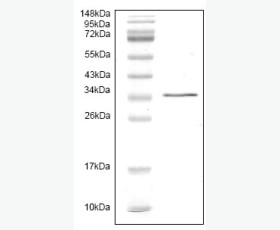Recombinant Human N-Acetylgalactosamine kinase/GALK2
| Product name: | Recombinant Human N-Acetylgalactosamine kinase/GALK2 |
| Source: | Human Cells |
| Purity: | Greater than 95% as determined by reducing SDS-PAGE. |
| Buffer Formulation: | Supplied as a 0.2 μm filtered solution of 20mM PB,150mM NaCl,pH7.4. |
| Applications: | Applications:SDS-PAGE; WB; ELISA; IP. |
| Storage: | Avoid repeated freeze/thaw cycles. Store at 2-8 oC for one month. Aliquot and store at -80 oC for 12 months. |
| UOM: | 100ug/50ug/200ug/1mg/1g |
| Source | Human Cells |
| Description | Recombinant Human Galactokinase 2 is produced by our Mammalian expression system and the target gene encoding Met1-Ala458 is expressed with a 6His tag at the C-terminus. |
| Names | N-acetylgalactosamine kinase, also known as GalNAc kinase, Galactokinase 2, GALK2 and GK2, is a member of the GHMP kinase family and GalK subfamily. |
| Accession # | Q01415 |
| Formulation | Supplied as a 0.2 μm filtered solution of 20mM PB,150mM NaCl,pH7.4. |
| Shipping |
The product is shipped on dry ice/ice packs. |
| Storage |
Store at < -20°C, stable for 6 months after receipt. Please minimize freeze-thaw cycles. |
| Purity |
Greater than 95% as determined by reducing SDS-PAGE. |
| Endotoxin | Less than 0.1 ng/µg (1 IEU/µg) as determined by LAL test. |
| Amino Acid Sequence |
MATESPATRRVQVAEHPRLLKLKEMFNSKFGSIPKFYVRAPGRVNIIGEHIDYCGYSVLPMAVEQ DVLIAVEPVKTYALQLANTNPLYPDFSTSANNIQIDKTKPLWHNYFLCGLKGIQEHFGLSNLTGM NCLVDGNIPPSSGLSSSSALVCCAGLVTLTVLGRNLSKVELAEICAKSERYIGTEGGGMDQSISF LAEEGTAKLIEFSPLRATDVKLPSGAVFVIANSCVEMNKAATSHFNIRVMECRLAAKLLAKYKSL QWDKVLRLEEVQAKLGISLEEMLLVTEDALHPEPYNPEEICRCLGISLEELRTQILSPNTQDVLI FKLYQRAKHVYSEAARVLQFKKICEEAPENMVQLLGELMNQSHMSCRDMYECSCPELDQLVDICR KFGAQGSRLTGAGWGGCTVSMVPADKLPSFLANVHKAYYQRSDGSLAPEKQSLFATKPGGGALVL LEAVDHHHHHH
|
| Background | GALK2 acts as a galactokinase when galactose is present at high concentrations. GALK2 may be involved in a salvage pathway for the reutilization of free GalNAc derived from the degradation of complex carbohydrates. GALK2 has been reported to participate in pathways , such as Amino sugar and nucleotide sugar metabolism, Galactose metabolism and Metabolic pathways. |














